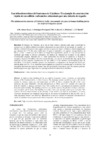Identificador persistente para citar o vincular este elemento:
https://accedacris.ulpgc.es/jspui/handle/10553/76739
| Título: | Las tobas/travertinos del Barranco del Calabozo | Autores/as: | Alonso Zarza, A. M. Rodríguez Berriguete, A Cabrera, M.C. Meléndez, A. Martín Rodríguez, L. F. |
Clasificación UNESCO: | 250804 Aguas subterráneas | Palabras clave: | Tufia (Telde, Gran Canaria) Travertine Degassing Plumber |
Fecha de publicación: | 2012 | Proyectos: | Valoracion de Procesos de Recarga y Descarga de Acuiferos Mediante Trazado Natural : Aplicacion en Gran Canaria CGL-2011-27826-C01-0 (Ministerio de Ciencia e Innovación) |
Publicación seriada: | Geotemas (Madrid) | Conferencia: | VIII Congreso Geológico de España | Resumen: | El barranco de Calabozo, en la Isla de Gran Canaria, muestra como rasgo excepcional la presencia de un edificio tobáceo/travertínico alimentado por una tubería de un sistema de regadío. La tubería se abasteció de pozos cuyas aguas son ricas en gases de origen volcánico y tienen temperaturas que alcanzan los 31ºC. En estas condiciones el agua se mineraliza con rapidez, enriqueciéndose en HCO3- y CO32-. Cuando sale de la tubería se desgasifica rápidamente (pierde el CO2) precipitando el carbonato que forma el edificio carbonático. El edificio del barranco de Calabozo es un edificio bioconstruido colgante, formado por: a) canal abastecedor (la tubería), b) pendiente c) barreras o cascadas y 4) pozas. El edificio funcionó escasas décadas y su tasa de crecimiento fue muy rápida. Esto explicaría los tres aspectos característicos de este edificio: 1) las barreras son bioconstrucciones de macrofitas, 2) las facies cristalinas gruesas son dominantes y responden a un desequilibrio fuerte por pérdida rápida de CO2 y 3) se observan rasgos diagéneticos a pesar de lo reciente que es el edificio. Las macrofitas ejercieron un papel de soporte para los precipitados inorgánicos, pero los microorganismos también jugaron un papel importante en la precipitación de las microfacies micríticas. A tufa/travertine building fed by an artificial irrigation system constitutes an outstanding feature of The Calabozo Gully, in Gran Canaria. The drainage system was fed by waters with elevate content in volcanic origin gas and temperature of 31ºC. In these conditions the pH of the water decreases, the water mineralizes very fast and increases its HCO3- and CO32- contents. As it goes out from the plumber, it degases and looses CO2. This enables the fast precipitation of carbonate and the formation of the building. The building consist on: a) a feeder channel, the plumber, b) slope, c) barriers and waterfalls and 4) pools. The building was active only a few decades and it grew very fast. This explains the main characteristics of the building: 1) the barriers are built by macrophytes, 2) coarse crystalline microfacies are dominant and formed by the strong disequilibrium by the fast CO2 lost, 3) some diagenetic features are observed. Macrophytes acted as a support for inorganic precipitation of calcite. In addition microorganisms also had an important role in micrite precipitation. |
URI: | https://accedacris.ulpgc.es/handle/10553/76739 | ISSN: | 1576-5172 | Fuente: | Geotemas (Madrid) [ISSN 1576-5172], v. 13, p. 44-47 |
| Colección: | Actas de congresos |
Visitas
75
actualizado el 30-dic-2023
Descargas
22
actualizado el 30-dic-2023
Google ScholarTM
Verifica
Comparte
Exporta metadatos
Los elementos en ULPGC accedaCRIS están protegidos por derechos de autor con todos los derechos reservados, a menos que se indique lo contrario.
